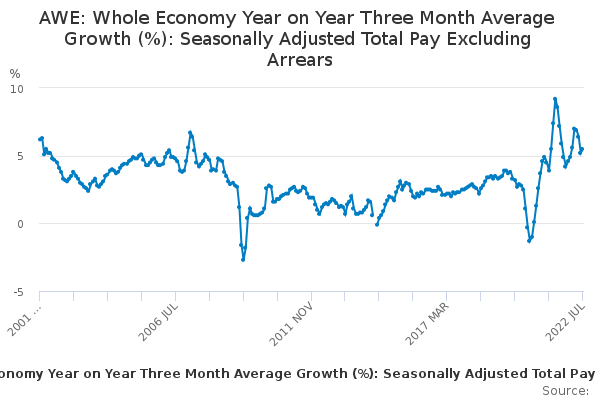20 years pay growth wiped out – what is really going on with the UK jobs market and how will it impact freelancers?
- Average pay was up by 4.3 per cent in the private sector between October-December 2021 including bonuses – that’s a good sign, but pay rises aren’t matching 2022 inflation. Freelancers are feeling squeezed
- Freelancers must know their market worth and what the going rate is for the types of services they provide to remain competitive and keep afloat financially
- Vacancies hit a high of 1.3 million – why aren’t positions getting filled? Is it “quiet quitting” or something else?
Were inflation to remain at around its current rate of just over 10 per cent, real wages in Britain are unlikely to fall any faster than they are now, though they are likely to keep falling for another year – by which time around 20 years of pay growth will have been wiped out.
That’s according to a report by Resolution Foundation which warns there are further signs that wider economic turmoil is beginning to affect the UK jobs market – a falling employment rate, diminishing vacancies and now redundancies bottoming out as signs that labour demand has started to fall as the economy plateaus.

Unlike any other time in history when the global economy was looking wobbly, 2022 is proving an enigma. Worryingly, the cost-of-living crisis has yet to encourage some people back into the workforce, said the report.
“Pay settlements strengthened over the summer, but not by enough to keep up with rapidly rising inflation,” said Gregory Thwaites, Research Director at the Resolution Foundation.
“As a result, pay packets have kept shrinking at close to their fastest rate since 1977. The only chink of light is that a more benign outlook for inflation means that they might not shrink any faster, although they won’t grow for another year.
The ONS latest labour market figures stated that the median weekly pay for full-time employees was £611 in April 2021, up 4.3% on a year earlier; this growth is the highest since 2008. Are you as a freelancer bringing in this much every week?
Higher-skilled: are they losing out on pay rises?
Pay increased for most workers in 2021, but particularly those that were most affected by the pandemic in 2020, most notably younger employees, men and the lowest-paid occupations. However, the highest paying occupations had the smallest increases between 2020 and 2021.
This isn’t particularly promising news for highly skilled freelancers that have had to up their rates to offset IR35/Off-Payroll tax hikes and umbrella company fees. Their rates may have “gone up” but those taking inside IR35 roles have seen their bank balances orse off, thanks to the double whammy of IR35 and the rise in inflation.
The latest research from IPSE has found that freelancers’ confidence in the UK economy for the next 12 months has fallen sharply from -27.4 in Q1 2022 to -56.7 this quarter. For context, this represents the lowest level of freelancer confidence in the economy since the early days of the pandemic in Q1 2020.
When analysing the reasons behind the recent fall in freelancer confidence, the FCI found that the state of the UK economy (77.8%) was the most detrimental factor impacting self-employed workers. This can be primarily attributed to the cost of the living crisis engulfing the UK as a result of rising inflation, the war in Ukraine, Brexit and rising energy and goods prices combining to heighten fears of an economic recession.
With inflation now projected to reach 18 per cent by early 2023, freelancers expect their day rates to increase by an average of 8.6 per cent over the next 12 months, according to IPS. But that’s only if they demand higher rates, and with more companies tightening their belts, freelancer bargaining power will be tested.
Freelancer workflow better than ever
The good thing is that the latest IPSE Confidence Index found that freelancers are working more than ever. Freelancers’ spare capacity has fallen from 3.2 weeks without work per quarter in Q1 2022 to 2.8 weeks this quarter. Alongside increases in day rates, this has meant that quarterly pay has increased to an average of £27,486 in Q2 2022.
This, however, is on the very high earning end of freelancer pay. For example, IPSE’s latest sentiment report found that freelancer day rates have increased from £516 in Q1 2022 to £528 this quarter. This has largely been driven by SOC3 associate professional and technical freelancers, who saw an increase in day rates from £308 in Q1 to £420 in Q2 2022.
Wider economic turmoil could affect the jobs market
“Instead of the cost-of-living crisis tempting people back into work, more people are exiting the jobs market altogether, primarily due to poor health reasons,” said the report.
But we could see more people out of work and for longer than they expected: one reason being self-motivated (quiet quitting) is happening just as companies are starting to make cutbacks and the other reason, recession-induced layoffs (startups are laying off in the US and Europe).
It might be freelancers, once again like in the pandemic, who fill in the skills gaps while the jobs market sorts itself out. But freelancers this time around should be well armed with what the going rates are for their services. Using sites such as Wethos could help them keep on top of industry rates and whether they have been setting their rates accordingly.
Other articles you may find useful:
What is the “new” creator economy and how can freelancers and contractors get in on the action?


